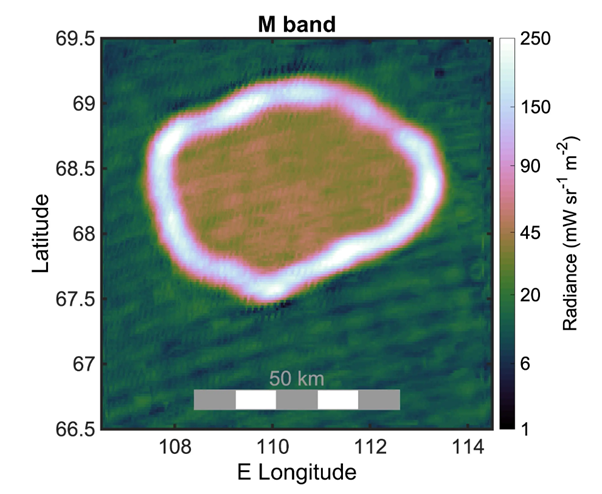The Juno spacecraft’s focus has turned from Jupiter itself to its moons, and a fly-by of Io has produced valuable data for understanding the Solar System’s most volcanic world. Among other things, it shows just how widespread Io’s lava lakes really are, and reveals that when a crust forms on them it is often surrounded by a ring of still-liquid lava.
When Galileo discovered Jupiter’s four largest moons, he considered them so interchangeable he was at first reluctant to name them, giving them numbers instead. The Voyager 1 spacecraft turned that on its head, revealing worlds with very different characters – most notably Io, perhaps the most distinctive world we have seen up close.
The Voyager craft spotted a volcanic eruption on Io and evidence this was the norm, not the exception. We now know Io has some large lava flows from these eruptions, but lava lakes within volcanic bowls known as paterae are much more common.
Io’s volcanism is a consequence of neighboring moons and Jupiter treating it like a stress ball, pulling and relaxing it in ways that release heat inside. Other moons are also affected, but only to the point of melting water to make internal oceans. The forces on Io are large enough to melt silicate rocks, causing magma to burst to the surface.
Juno passed by Io at a distance of 35,000 kilometers (21,700 miles or a tenth the distance from Earth to the Moon) in May 2023. The Galileo Spacecraft got much, but Juno is equipped with better instruments, including the Jovian Infrared Auroral Mapper (JIRAM), which like the JWST operates in infrared.
Like a lot of Juno’s equipment, JIRAM was designed for what it could tell us about Jupiter, but its capabilities turn out to be quite well suited for investigation of the moons.
“The high spatial resolution of JIRAM’s infrared images, combined with the favorable position of Juno during the flybys, revealed that the whole surface of Io is covered by lava lakes contained in caldera-like features,” said Dr Alessandro Mura of the National Institute for Astrophysics in Rome in a statement. “In the region of Io’s surface in which we have the most complete data, we estimate about 3 percent of it is covered by one of these molten lava lakes.” That’s equivalent to if the lava-filled craters left behind by volcanic eruptions on Earth covered a combined area almost as large as Russia.
Chors Patera, a lava lake on Io, reveals a hot ring around its edge when seen in infrared. The lake is thought to be largely covered by a thick, molten crust, with a hot ring around the edges where lava from Io’s interior is directly exposed to space.
Image Credit: NASA/JPL-Caltech/SwRI/ASI/INAF/JIRAM/MSSS
Sunlight at Io is far too weak to keep the lava liquid for long, so a crust quickly forms on each lake’s surface. However, JIRAM has shown that in some cases a liquid rim survives around the edge, but with no sign of spilling over. Instead of throwing a ring into the fire, on Io, the rings themselves are fiery.
Mura and co-authors think they can identify similar, although much rarer, situations on Earth.
“We now have an idea of what is the most frequent type of volcanism on Io: enormous lakes of lava where magma goes up and down,” said Mura. “The lava crust is forced to break against the walls of the lake, forming the typical lava ring seen in Hawaiian lava lakes. The walls are likely hundreds of meters high, which explains why magma is generally not observed spilling out of the paterae [bowl-shaped features created by volcanism] and moving across the moon’s surface.”
In this view, friction between the crust and the surrounding walls breaks the crust at the edges, allowing us to see the still-molten material beneath. The researchers studying Juno’s images have an alternative explanation, although they consider it less likely. In this view, magma rises near the center of the lake and forms a crust that sinks towards the outskirts, allowing lava to be seen over the top.
Juno has made four subsequent Io flybys, some of them considerably closer, since the one the study is based on, and another is coming soon. Images from these are still being investigated, and may settle the debate as to what is producing these lava rings, which could be fed into models of how magma rises on Io, helping us understand its interior.
The study is published open access in Communications Earth and Environment.
Source Link: Close-Up Of Io’s Lava Lakes Reveal Many Have Fiery Rings
